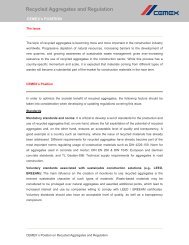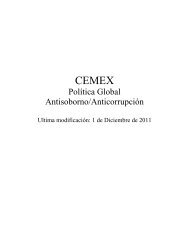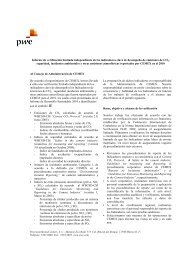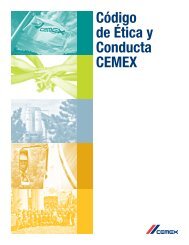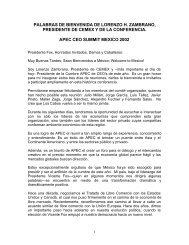- Page 1:
CEMEX 2010 20F REPORT building a ST
- Page 4 and 5:
Securities registered or to be regi
- Page 6 and 7: Qualitative and Quantitative Market
- Page 9 and 10: INTRODUCTION CEMEX, S.A.B. de C.V.
- Page 11 and 12: As a result of the foregoing transa
- Page 13 and 14: In the U.S., the recession was long
- Page 15 and 16: The Financing Agreement contains ev
- Page 17 and 18: The Financing Agreement restricts u
- Page 19 and 20: During 2009, we reduced the aggrega
- Page 21 and 22: The instruments governing our debt
- Page 23 and 24: On the legislative front, during th
- Page 25 and 26: Our operations in South America, Ce
- Page 27 and 28: the depositary to vote the CPOs und
- Page 29 and 30: Beginning in 2008, MFRS B-10 has el
- Page 31 and 32: (1) Cost of sales includes deprecia
- Page 33 and 34: Item 4 - Information on the Company
- Page 35 and 36: As a condition to closing the RMC a
- Page 37 and 38: Provide our customers with the best
- Page 39 and 40: In connection with the implementati
- Page 41 and 42: In 2010, as a result of our efforts
- Page 43 and 44: In addition, we are one of the worl
- Page 45 and 46: (2) Our cement raw materials operat
- Page 47 and 48: Our Corporate Structure We are a ho
- Page 49 and 50: Cement in Mexico is sold principall
- Page 51 and 52: Aggregates. Our aggregates operatio
- Page 53 and 54: Beginning on June 30, 2008, Ready M
- Page 55: Products and Distribution Channels
- Page 59 and 60: Ready-Mix Concrete. Our ready-mix c
- Page 61 and 62: Aggregates. In 2010, we reduced fix
- Page 63 and 64: Our Operating Network in France Des
- Page 65 and 66: In April 2006, we initiated an expa
- Page 67 and 68: Our Operating Network in Colombia P
- Page 69 and 70: Our Operations in Nicaragua Overvie
- Page 71 and 72: Our Operations in the United Arab E
- Page 73 and 74: Our Trading Operations In 2010, we
- Page 75 and 76: On December 10, 2010, after receivi
- Page 77 and 78: To prevent, control and remediate e
- Page 79 and 80: As required by the directive, each
- Page 81 and 82: For the 2010 fiscal year, CEMEX wil
- Page 83 and 84: Separately, the government of Venez
- Page 85 and 86: and CEMEX was required by August 11
- Page 87 and 88: January 1, 2008, however, under MFR
- Page 89 and 90: foreign subsidiaries. These instrum
- Page 91 and 92: Valuation reserves on accounts rece
- Page 93 and 94: Stage 1. Communication to the organ
- Page 95 and 96: Year Ended December 31, 2010 Compar
- Page 97 and 98: Geographic Segment 89 Variations in
- Page 99 and 100: United Kingdom Our domestic cement
- Page 101 and 102: ended December 31, 2010, Africa and
- Page 103 and 104: Operating Income. For the reasons m
- Page 105 and 106: Our comprehensive financing result
- Page 107 and 108:
The following tables present select
- Page 109 and 110:
Mexico Our domestic cement sales vo
- Page 111 and 112:
As a result of the decreases in dom
- Page 113 and 114:
For the year ended December 31, 200
- Page 115 and 116:
South America, Central America and
- Page 117 and 118:
For the year ended December 31, 200
- Page 119 and 120:
For the year ended December 31, 201
- Page 121 and 122:
On August 14, 2009, we entered into
- Page 123 and 124:
As of December 31, 2010, we had U.S
- Page 125 and 126:
Our Perpetual Debentures As of Dece
- Page 127 and 128:
The Financing Agreement, as amended
- Page 129 and 130:
In 1999, CEMEX entered into an agre
- Page 131 and 132:
Our Equity Derivative Forward Contr
- Page 133 and 134:
As of December 31, 2009 and 2010, C
- Page 135 and 136:
In addition, we have entered into f
- Page 137 and 138:
Private Cash Tender Offer to Holder
- Page 139 and 140:
Name, Position (Age) Experience Jai
- Page 141 and 142:
Name, Position (Age) Experience Ram
- Page 143 and 144:
Tomás Milmo Santos (46) Has been a
- Page 145 and 146:
Set forth below are the names of th
- Page 147 and 148:
Consolidated ESOP Information Stock
- Page 149 and 150:
Item 7 - Major Shareholders and Rel
- Page 151 and 152:
The following table sets forth the
- Page 153 and 154:
Item 10 - Additional Information Ar
- Page 155 and 156:
exempt from registration pursuant t
- Page 157 and 158:
Our board of directors shall prepar
- Page 159 and 160:
Under our by-laws, shareholders rep
- Page 161 and 162:
On June 2, 2008, CEMEX, through one
- Page 163 and 164:
Exchange Controls See “Item 3 —
- Page 165 and 166:
The gross amount of any dividends p
- Page 167 and 168:
We have agreed to pay some of the o
- Page 169 and 170:
Item 16G - Corporate Governance Sec
- Page 171 and 172:
Item 17 - Financial Statements Not
- Page 173 and 174:
4.17 Debenture Purchase Agreement,
- Page 175 and 176:
4.27.3 Amendment No. 1 to U.S.$525,
- Page 177 and 178:
4.41.4 Accession Letter, dated Janu
- Page 179 and 180:
4.57 Amended and Restated Dealer Ma
- Page 181:
SIGNATURES CEMEX, S.A.B. de C.V. he
- Page 184 and 185:
The Board of Directors and Stockhol
- Page 186 and 187:
CEMEX, S.A.B. DE C.V. AND SUBSIDIAR
- Page 188 and 189:
CEMEX, S.A.B. DE C.V. AND SUBSIDIAR
- Page 190 and 191:
1. DESCRIPTION OF BUSINESS CEMEX, S
- Page 192 and 193:
C) USE OF ESTIMATES CEMEX, S.A.B. D
- Page 194 and 195:
J) IMPAIRMENT OF LONG LIVED ASSETS
- Page 196 and 197:
Contingencies and commitments (note
- Page 198 and 199:
CEMEX, S.A.B. DE C.V. AND SUBSIDIAR
- Page 200 and 201:
V) CONCENTRATION OF CREDIT CEMEX, S
- Page 202 and 203:
CEMEX, S.A.B. DE C.V. AND SUBSIDIAR
- Page 204 and 205:
CEMEX, S.A.B. DE C.V. AND SUBSIDIAR
- Page 206 and 207:
Net sales by product and geographic
- Page 208 and 209:
4. CASH AND INVESTMENTS CEMEX, S.A.
- Page 210 and 211:
CEMEX, S.A.B. DE C.V. AND SUBSIDIAR
- Page 212 and 213:
CEMEX, S.A.B. DE C.V. AND SUBSIDIAR
- Page 214 and 215:
CEMEX, S.A.B. DE C.V. AND SUBSIDIAR
- Page 216 and 217:
CEMEX, S.A.B. DE C.V. AND SUBSIDIAR
- Page 218 and 219:
CEMEX, S.A.B. DE C.V. AND SUBSIDIAR
- Page 220 and 221:
CEMEX, S.A.B. DE C.V. AND SUBSIDIAR
- Page 222 and 223:
II. Equity forwards in third party
- Page 224 and 225:
14. EMPLOYEE BENEFITS Defined contr
- Page 226 and 227:
CEMEX, S.A.B. DE C.V. AND SUBSIDIAR
- Page 228 and 229:
CEMEX, S.A.B. DE C.V. AND SUBSIDIAR
- Page 230 and 231:
CEMEX, S.A.B. DE C.V. AND SUBSIDIAR
- Page 232 and 233:
17. EXECUTIVE STOCK-BASED COMPENSAT
- Page 234 and 235:
18. EARNINGS (LOSS) PER SHARE CEMEX
- Page 236 and 237:
D) CONTRACTUAL OBLIGATIONS CEMEX, S
- Page 238 and 239:
CEMEX, S.A.B. DE C.V. AND SUBSIDIAR
- Page 240 and 241:
CEMEX, S.A.B. DE C.V. AND SUBSIDIAR
- Page 242 and 243:
CEMEX, S.A.B. DE C.V. AND SUBSIDIAR
- Page 244 and 245:
CEMEX, S.A.B. DE C.V. AND SUBSIDIAR
- Page 246 and 247:
Reconciliation of stockholders’ e
- Page 248 and 249:
CEMEX, S.A.B. DE C.V. AND SUBSIDIAR
- Page 250 and 251:
CEMEX, S.A.B. DE C.V. AND SUBSIDIAR
- Page 252 and 253:
CEMEX, S.A.B. DE C.V. AND SUBSIDIAR
- Page 254 and 255:
CEMEX, S.A.B. DE C.V. AND SUBSIDIAR
- Page 256 and 257:
CEMEX, S.A.B. DE C.V. AND SUBSIDIAR
- Page 258 and 259:
(k) Other U.S. GAAP Adjustments Def
- Page 260 and 261:
CEMEX, S.A.B. DE C.V. AND SUBSIDIAR



